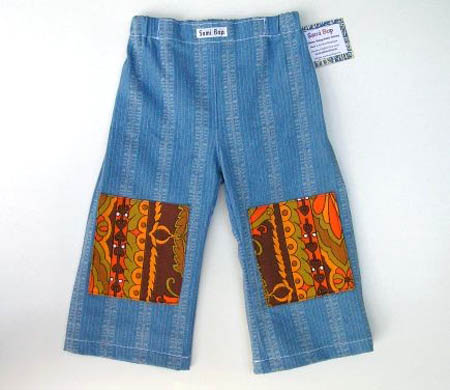Clothes are an inevitable expense that everyone comes across at some point or another. While cutting this expenditure completely is not usually feasible, by using smart money sense, you can minimize this expense greatly.
This post is Part 3 in my Cutting Clothing Costs series.
Sewing to Save Money
 Too many times I’ve seen people chuck a piece of clothing because of minor damage that can easily be corrected with a needle and thread.
Too many times I’ve seen people chuck a piece of clothing because of minor damage that can easily be corrected with a needle and thread.
Learn to Sew. It behooves one to learn how to sew, as this simple skill can save you lots of money, even without owning a sewing machine. I’ve included some links to instructional videos so that you can learn to repair your clothes without needing to pay for sewing lessons. For other instructions, see this youtube beginner’s sewing channel.
Seamstress. Even if learning isn’t an option, even paying a seamstress to mend your clothes will save you money, as repairing clothes is cheaper than buying new.
Mending
Buttons. Save buttons when they fall off and simply sew them back on. (How-to video here.) If you lost the button, note that most clothes have a spare button sewn onto the bottom or an inside tag precisely for this reason.
If there are no spare buttons, consider taking the top button off the shirt and use it where the button is missing, and use a different coordinating button on the top. This can be a fashion statement. Alternatively, you can replace all the buttons on the outfit (or all of a similar type- like all the collar buttons or the ones going down the middle of a shirt) for cheaper than replacing the whole outfit. Thrift stores and discarded clothes are good sources of buttons.
Opened Seams. This is the simplest type of mending that saves so many clothes. You merely need to sew a simple stitch across where the seam used to be, either by hand or with a machine. Instructions here.
Ripped Fabric. There are a few options for repairing clothing that tore the actual fabric and not only the seam. If pants have torn at the knee, consider cutting legs off at the height of the hole to make shorts.
 Alternatively, you can patch the fabric. This can be done either unobtrusively or boldly, depending on where the clothing was torn. There are pretty patches available to be sewn on tastefully, decoratively. If pants have torn or worn out at the knee, you can simply sew identical contrasting squares of fabric on the knee as a fashion statement. They’re so cute that pants are even sold that way sometimes.
Alternatively, you can patch the fabric. This can be done either unobtrusively or boldly, depending on where the clothing was torn. There are pretty patches available to be sewn on tastefully, decoratively. If pants have torn or worn out at the knee, you can simply sew identical contrasting squares of fabric on the knee as a fashion statement. They’re so cute that pants are even sold that way sometimes.
If you don’t want the patch to stand out, you can sew patches onto the inside of the clothing so that only the smallest hint of the patch is seen, if even. See instructions for sewing on patches here for more detail.
Iron on patches are available for greater ease, but they are more expensive. Pins and recycled materials should do the trick if you’re handy with a needle and thread.
Broken Zippers. Buying a new zipper is so cheap; what a pity to throw out expensive clothing because of broken zippers. I’ll admit that I don’t really know how to replace zippers yet, but paying a seamstress to replace that nonfunctional zipper is still infinitely cheaper than buying a new winter coat. (Yes, the zippers on both my expensive winter coats broke.) When replacing zippers, consider recycling working zippers from clothing that has become irreparably damaged and is heading towards the trash can.
Replacing Elastic. This can be extremely simple or plain old simple. No need to throw out clothing when elastic has been stretched beyond repair. Simply replace the elastic with new, working elastic. (Video here.) Occasionally no sewing whatsoever is required!
Lengthening Clothing Life by Sewing.
While mending plays a huge part in using needle and thread to save your clothes, sometimes sewing can bring new life to clothes that would be otherwise case aside.
 Adjusting Hems. Kids shoot up like weeds. To avoid buying clothes, only to have them be too short on your children in just a few weeks, buy skirts, pants, and dresses too long. Fold up the bottom and hem the clothes to the length that currently suits your child. When your children outgrow that, let down the hem you sewed, and you’ll have proper length clothing again.
Adjusting Hems. Kids shoot up like weeds. To avoid buying clothes, only to have them be too short on your children in just a few weeks, buy skirts, pants, and dresses too long. Fold up the bottom and hem the clothes to the length that currently suits your child. When your children outgrow that, let down the hem you sewed, and you’ll have proper length clothing again.
Sometimes the factory sewn hem can be quite large, and with a bit of dexterity, you can let down the hem even more, sewing your own minuscule hem, adding even more inches on to the bottom.
These both can be done without a machine. Video Instructions.
When there is no more seam to let down, you can add length by adding ruffles on to the bottom. Dresses and skirts only, please!
Adjusting Waists. I’m a mother. I know all about fluctuations in waist sizes, especially due to pregnancy and stubborn baby weight. Buying a new wardrobe because nothing fits seriously stinks! (Though it is a nice feeling when your clothing is too big on you, you still don’t always have the money to buy so many more clothes in your new size.) Consider taking in a waist by adding darts, or enlarging a waist when that skirt simply won’t fit anymore. Alternatively, you can buy larger skirts and sew in elastic, making sure that your clothes will fit you throughout all your bodily fluctuations.
 Converting Clothes. Skirts and pants can be converted to maternity wear. Pants can be made into skirts. Regular bras can be made into nursing bras. (You may just need a seamstress for that.) The options are limitless! Don’t assume that your old clothes can never be worn again. Bring your old clothes to a new stage in life.
Converting Clothes. Skirts and pants can be converted to maternity wear. Pants can be made into skirts. Regular bras can be made into nursing bras. (You may just need a seamstress for that.) The options are limitless! Don’t assume that your old clothes can never be worn again. Bring your old clothes to a new stage in life.
~ ~ ~ ~
Go grab your needle and thread before tossing those clothes. With a little loving, your old clothes will see the light of day again very soon.
How have you lengthened the life of your clothes via sewing? Do you know how to sew?
This is part of the Cutting Clothing Costs series.
Part 1- Stain Fighting
Part 2- Launder Correctly to Save Your Wardrobe
Part 3- Sew to Save Your Clothes
Part 4- Forget Ironing (Coming soon!)




